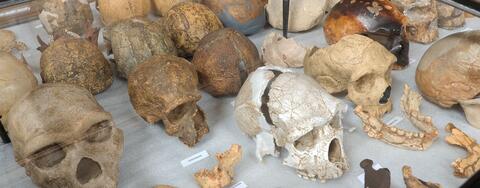
In Search of the Origins of Language
Spoken language is thought to be unique to the human species. But when and how did this ability emerge during our evolution?
The Origins of Speech
This fascinating question is explored by the interdisciplinary research project "Origins of Speech," led by paleoanthropologist Amélie Vialet at the Institute for Computing and Data Sciences (ISCD). The challenge? Reconstruct, through bone fragments and digital modeling, the tongue muscles of these extinct human species and attempt to put a face to our distant ancestors.
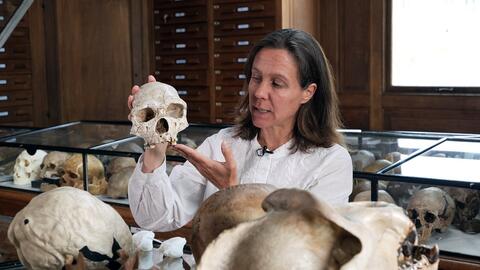
A Quest Through Human Fossils
As the foundation of communication, culture, and abstract thought, language is one of the most distinctive features of humans. However, uncovering the mysteries of its emergence in evolutionary history remains a major scientific challenge. "Speech production involves many organs and soft tissues, such as the brain, tongue, and larynx, which do not fossilize. Thus, we only have indirect evidence of language in extinct human species," explains Amélie Vialet, paleoanthropologist at the French National Museum of Natural History and director of the project.
According to Vialet, it's relatively straightforward to assert that early Homo sapiens mastered spoken language, as their anatomy closely resembles ours, and their material creations show technical and abstract sophistication comparable to ours. However, proving this for earlier periods is more complicated. The individuals who lived 500,000 years ago left traces that differ anatomically and culturally. "They lack a chin, have a flattened forehead, and display a prominent brow ridge," notes Amélie Vialet. "Moreover, the indicators of abstract thought that we infer from their material creations are less striking than the cave paintings of the first Homo sapiens, though some of their behaviors may be considered symbolic."
Analyzing the fossil skulls of these distant relatives reveals information about their brains, such as the presence of a small protrusion in the frontal lobe known as Broca's cap, considered since the 19th century as the center of spoken language. "However, we also find this structure in our closest cousins, like gorillas and chimpanzees, and even in more distant primates like baboons. Its presence alone doesn't necessarily imply the production of spoken language," says Vialet.
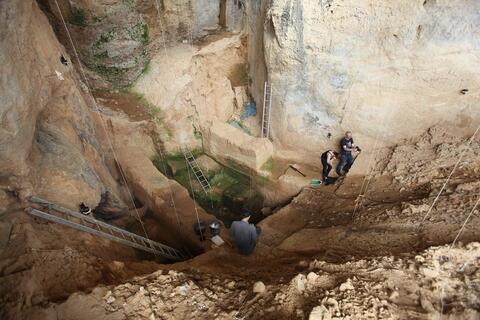
Fouilles dans la grotte de Tautavel © Denis Dainat/EPCC-CERP Tautavel
The Fall of Traditional Paradigms
The complexity of language relies on numerous organs, not just this brain region. In the 1960s, anatomist Philipp Lieberman proposed that the low position of the human larynx enables the production of varied sounds, unlike quadrupeds with higher larynxes that limit sound production. This theory was long used to explain why only Homo sapiens could articulate complex sounds.
"This paradigm is now widely questioned," says Amélie Vialet. "Recent studies on the vocalizations of non-human primates, like baboons, show they can produce tongue movements similar to those required to articulate basic vowels. This suggests that they might physically be able to articulate sounds comparable to those of modern humans."
The Necessity of an Interdisciplinary Approach
In this context, the Origins of Speech project was launched in 2017, aiming to reconstruct soft tissues, particularly the tongue, from human fossils. "We’ve brought together experts from various fields, including mathematicians specializing in modeling, biomechanists, primatologists, bioacousticians, and paleoanthropologists," says Amélie Vialet.
The project's first step was to create a biomechanical model of the tongue of these extinct human species. To achieve this, Vialet collaborated with researchers from the University of Grenoble. "For 30 years, we have modeled the human tongue, a highly complex organ with 17 muscles, to assist surgeons in their procedures," explains Yohann Payan, CNRS research director at the University of Grenoble and an expert in biomechanics and digital reconstruction of soft tissues. "The idea was to transpose this model onto the fossilized skulls of different human species to test their vocal capabilities and understand how the tongue's anatomy may have evolved over time," he explains.
Yet, a major question remained: could the biomechanical tongue model developed by Grenoble researchers be adapted to anatomies different from that of Homo sapiens? To answer this, they tested their model on the baboon, a primate whose morphology is very different from ours. "We showed that even with a very different anatomy, we could reconstruct the soft tissues of the oral cavity with sufficient precision," says Yohann Payan. They also collaborated with primatologists, like Marion Laporte, who studies vocal production mechanisms in non-human primates, notably chimpanzees, bonobos, and baboons.
The First Reconstruction of a Fossil Human Tongue
Encouraged by these promising results, the researchers applied their model to human fossils, notably Arago 21, a specimen 450,000 years old found in the Caune de l’Arago cave in Tautavel. "This individual is the oldest discovered in France and could be linked to the Neanderthal lineage that later developed. For the first time, we recreated the soft tissues of a fossil, but it's mainly a highly precise biomechanical model that can be activated to produce sounds," says Vialet enthusiastically. Early observations are already revealing. The tongue of Arago 21, though of the genus Homo, shows significant differences from that of modern Homo sapiens. It is slightly lower and longer, features consistent with the fossil's ancestral position compared to Neanderthals, known for their forward-projecting faces and elongated skulls.
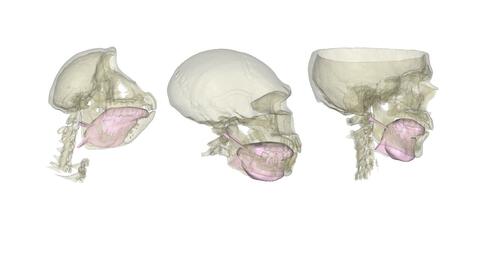
De droite à gauche : Langue d'un babouin, langue de Arago 21, langue d'un homme actuel ©MNHN
Beyond the Tongue: Reconstructing the Face of a Prehistoric Human
The Origins of Speech project extends beyond modeling the tongue to include the reconstruction of fossil humans’ faces. Nicolas Leys, a scientific visualization engineer at ISCD, explains: "We thought of applying to prehistoric humans, like Arago 21, the facial reconstruction techniques developed a few years ago by the Facile chair. This multidisciplinary ISCD research chair, bringing together physicians, mathematicians, and 3D modeling experts, developed an algorithm capable of generating a face from a skull using a skull-face data pair database."
To achieve this facial reconstruction, the researchers first had to obtain a complete digital skull. "In archaeology, fossils are often incomplete and distorted, and their restoration involves virtual anthropology techniques," explains Vialet. "These are literal bone puzzles we can precisely reposition thanks to the 3D model." This step is crucial to ensure the models are faithful to paleontological realities. Florent Goussard, a 3D imaging engineer at the Paris Research Center in Paleontology (MNHN, CNRS, Sorbonne University), describes his role: "My task is first to reconstruct the often fragmented and distorted fossil skulls to make them as complete as possible. I use 3D modeling software for this. Once this stage is complete, there are missing details, especially in the teeth, often lost during fossilization, which I add virtually."

Modélisation du crâne d'Arago 21 - © Florent Goussard - MNHN/ISCD
Once the skull is complete, Nicolas Leys uses the "Facile" algorithm to create a digital face free of secondary characteristics. However, this algorithm, based on modern skull data, doesn’t account for Neanderthal fossil specifics. For instance, it preserves a forehead and chin, absent in these species. Florent Goussard must then intervene again to adapt these reconstructions. "I adjust the key elements by adding a thick brow ridge, absent in Homo sapiens, removing the chin, and elongating the skull to create a face more true to Neanderthal anatomy," he says.
This approach deconstructs stereotypes and provides a more realistic vision of our ancestors. "The first reconstructions we've completed with this 3D model show prehistoric faces with a more natural appearance and sometimes finer features than we imagined. They differ from traditional artistic representations, often very muscular or robust," notes the paleontologist.
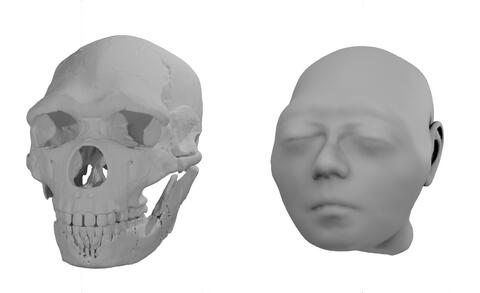
Modélisation avec l'algorithme Facile du visage d'Arago 21 à partir de son crâne reconstruit numériquement © Nicolas Leys et Florent Goussard - ISCD/MNHN
Outlook
The Origins of Speech project paves new ways to understand the evolution of human language through a direct approach to the tongue, the primary organ involved. This initial step has helped to clarify its specificities in fossil humans. "The next phase of our research will involve activating these biomechanical models to determine what kinds of sounds these individuals might have produced," says Vialet. After studying fossils of early Neanderthals like Arago 21 and other species close to Homo sapiens, the team also hopes to expand their research to even older ancestors, such as Australopithecus. "These fossils, dating back 3 million years, have a morphology even more different from ours. We now have tools that will allow us to explore their vocal capabilities and perhaps radically change our understanding of language evolution," concludes the researcher.
